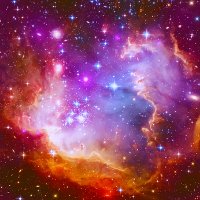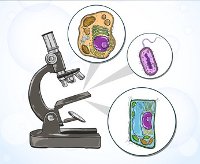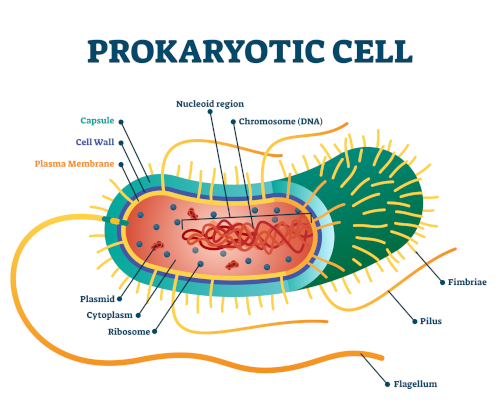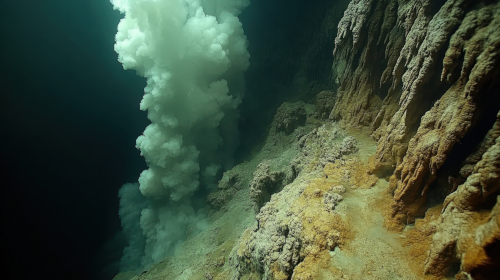Why Does Life Exist?
Is this the ultimate question? And is there an ultimate answer? The question "why does life exist?" can be answered in different ways depending on your definition of life.
On the main page about life we contrasted scientific, philosophical, historical and everyday definitions of life with a spiritual one. Here, we'll answer the question in both scientific and spiritual terms. But first, let's think about what the question actually means!
Whatever our view of life, the question "why does life exist?" has two main parts:
- What are we after when we ask "why?"
- What do we mean by "existence" in relation to "life"?
Let's look at each part separately before we attempt to answer the main question.
Part 1. The Meaning of "Why?"
 Everything happens for a reason; ID 72889621 © gustavofrazao | Adobe.com
Everything happens for a reason; ID 72889621 © gustavofrazao | Adobe.comThe question "why does life exist?" is looking for a reason behind the existence of life. There are two different kinds of reason we can aim to provide: one explains "the cause"; the other explains "the purpose".
Purpose implies intention to achieve a goal. Intention is associated with consciousness. Purpose therefore implies some kind of consciously directed action towards achievement of a goal. "Why did you buy that hat?" is asking for your purpose in buying the hat - even if you failed to achieve it!
On the other hand, a cause can be unconnected with consciousness or intention. We would expect, for example, a scientific answer to the question "why is the sky blue?" to be given completely in physical terms. As in: white sunlight has all the colours of the spectrum in it, including blue and red. Air molecules scatter the blue light much more than the red. So unless you are looking directly at the Sun, the sky above appears blue.
Similarly, when we ask the question "why does life exist?" we might expect two different kinds of answer, depending on whether we think life has a purpose or whether we think it is purely a consequence of a physical cause.
A scientific reason in answer to "why does life exist?" would explain the physical cause of life. A spiritual reason would add something about consciousness and provide a purpose to the existence of life.
Part 2. Existence and Life
 Birth of stars;
ID 87574543 © korionov | Adobe.com
Birth of stars;
ID 87574543 © korionov | Adobe.comThe existence of real objects
 Two young children playing with toys;
ID 17377982 © Xiao Zhang | Dreamstime.com
Two young children playing with toys;
ID 17377982 © Xiao Zhang | Dreamstime.comWhen we say that something "exists", we imply that it has an objective reality. In other words, it can be perceived, not only by me but also by others. I can see a stone on the ground and pick it up and so could you. We can agree that it exists.
In that way we can readily agree that many physical aspects of our shared world really exist because we collectively experience them as objectively real. Rocks, rivers, mountains; bricks, tables, spoons; trees and flowers; frogs and birds and bees.
That is easy. However, there are many things that we experience in life, even collectively, that are not entirely physical, yet we would commonly believe them to exist. They can still be "objective" but in a mental or cultural sense, like certain thoughts or scientific theories or works of art or music or literature. Or the design of a building designed to inspire, such as a great cathedral. The building itself is physical but the design springs from the intent, imagination and knowledge of the architect - all mental and cultural aspects of the reality of human life.
A scientific theory can be described in a book or a lecture, both of which are physically real - but the theory itself is a collection of ideas which are mental in origin not physical.
Yet, having read the book or heard the lecture, we would not doubt that the theory exists.
Does my mind exist?
 Rene Descartes 1596-1650;
ID 32220332 © Georgios Kollidas| Adobe.com
Rene Descartes 1596-1650;
ID 32220332 © Georgios Kollidas| Adobe.comDoes my mind exist? Certainly it does to me - but, unless you are completely telepathic, how would you know? You can hear me speak about my thoughts and my words may make sense to you - and you may therefore believe that I have a mind, but can you be really sure? How do you know that I am not like a sophisticated robot with artificial intelligence, with no mind or consciousness of my own? Perhaps I am programmed like a computer to speak to you and say "I am conscious", even though there may be no "I" inside my body at all!
After
all, my Sat-Nav gives me clear travel directions in a realistic female human
voice, complete with English accent, but I do not believe there is a
human mind inside the little box.
My own awareness is peculiar to me. I know that I exist but you cannot really be sure that I am a conscious human being, even though you can see and touch my physical body. Even though we
take each other's inner existence for granted when we communicate.
The French philosopher and mathematician Rene Descartes famously said "I think therefore I am". He avoided the question "why does life exist?" by starting with the fact of his own existence. He knew that he existed because he experienced his own thoughts. His existence was, in that sense, self-evident. Just as your own existence is self-evident to you and mine to me.
Descartes went on to say that there were
two parts to existence, an outer or material part and an inner or mental
part. (Today we would say "physical" rather than "material", since in
science we think that matter is a kind of energy).
Human life has both outer and inner aspects: physical and
mental; bodies and minds. And much of human life, the social and
cultural aspect, exists as a combination of both. Think again of the
scientific theories, the works of art and music and literature. And of
our buildings and roads and transport systems, our communications
networks and our organisations. They are all a combination of mental and
physical factors.
Does human life exist? Of course it does - and we must therefore consider the inner aspects of life as well as the outer when we try to answer our question "why does life exist?".
Is consciousness necessary for existence?
 Full Moon seen clearly at night; ID 42638075 © David Carillet | Adobe.com
Full Moon seen clearly at night; ID 42638075 © David Carillet | Adobe.comThere is another point to be made about "existence" and it is one that has vexed our best scientific minds. Albert Einstein once asked a friend if he really believed the moon only exists when someone looks at it. This was a puzzle from quantum physics, which says that tiny physical objects such as electrons exist as a "wave function" when they are not being observed. The wave function is a kind of probability wave - a mathematical expression which combines all the possible ways the electron might exist and says how that changes as time goes by.
According to this scientific idea, the electron only has a defined physical existence as a particle in "the here and now" when the wave function is "collapsed" by an observation. In other words, when the electron is not being observed, it exists in an indeterminate state. It some weird sense it exists everywhere, all at the same time. Its actual existence in the state we perceive it through our measuring instruments is only determined when we make an observation.
Therefore, the meaning of the existence of the electron is quite different between when it is being observed and when it is not.
Is the same true of the Moon? Or the universe? or Life on Earth?
Of course, Life on Earth is being observed all the time (by
someone or other) so does it really matter? Well it does if we want a
causal explanation which goes back in time to before humans existed.
When there were no humans around to observe Life on Earth, did it exist in the same way that it does now? Or was it in some kind of indeterminate state representing a mixture of various probabilities? There is no way of knowing for sure!
But if the existence of anything requires a conscious act of perception before it can be validated then it is reasonable to expect a purposeful answer to the question "why does life exist?" as well as a causal one.
Why does life exist? A scientific answer
 Microscope and single cells of life;
ID 139577134 © Aglia | Adobe.com
Microscope and single cells of life;
ID 139577134 © Aglia | Adobe.comCells, organisms and the genetic code
Science describes life in terms of self-organising biological systems called organisms. Organisms are made of cells. Some organisms have only one cell (e.g. a bacterium), others have trillions (e.g. a human being) but all life as we know it today is made of cells. So the question "why does life exist?" turns into the scientific questions: "why do cells exist" and "why do cells evolve into different organisms?"
A cell is a microscopically small unit of life separated from its environment by a membrane (the cell wall). The cell wall has small holes in it which allow nutrients and water to flow in and waste (and other products) to flow out.
Inside the wall, the cell is made of a jelly called cytoplasm in which are embedded different structures which give the cell a shape - and tiny organs which help it to function. For example, the ribosomes make proteins (the building blocks of the body), the mitochondria generate energy and the nucleus (found in animal and plant cells) carries the chromosomes. There are other tiny organs which deal with toxins, kill invading bacteria, recycle materials and process waste. Some of the proteins that are made in the cell act as enzymes, which control chemical reactions in the body.
Even though cells are (usually) very very small, they are also very complex.
Chromosomes are found inside nearly all cells, even cells which don't have a nucleus such as a bacterium. The chromosomes are very long, string-like structures (coiled up in some way so they fit in the cell) and they carry the DNA molecules - and hence the genetic code for that species.
The genetic code contains the exact instructions for the cell to make proteins, so that it can grow, maintain itself and reproduce. What kind of cell it is to start with (e.g. animal, plant, bacterium etc.) and the exact instructions contained in the genetic code, together determine what the fully grown organism will look like and what it can do. So the existence of the genetic code in cells is one part of the scientific answer to the question "why does life exist?"
Evolution through mutations and natural selection
 Evolution of life; ID 228357647 © VectorMine | Dreamstime.com
Evolution of life; ID 228357647 © VectorMine | Dreamstime.comLife on Earth as we know it today exists due to the laws of evolution. Although the genetic code for any species is very stable, it can spontaneously undergo small changes (mutations). These mutations lead to natural variations in the physical character of the organism. Natural selection (i.e. "survival of the fittest") makes sure that the variations that are best adapted to changing environmental conditions are the ones that survive and reproduce. Those surviving variations pass their genes onto their offspring.
Why does life exist in the form that we know it? Because primitive organisms evolved into more complex ones. Over long periods of time, this process leads to the evolution of new species and to changes in the character of Life on Earth.
A common ancestor?
 Prokaryotes, an ancient single-celled life form; ID 169963022 © VectorMine | Dreamstime.com
Prokaryotes, an ancient single-celled life form; ID 169963022 © VectorMine | Dreamstime.comBiologists believe that all the life on Earth today evolved from a common single-celled ancestor which first appeared on Earth
around 3.8 billion years ago. To go further with the scientific answer
to the question "why does life exist?" we need to explain how that very
primitive ancestral life form first appeared on Earth.
Scientists think that the basic biological molecules needed for
cells, such as amino acids and sugars, were created from the simpler
molecules available on Earth at that time, through natural processes
such as lightning storms. Or possibly they came in meteors from outer
space!
"Why does life exist?" then becomes: "how did those biological molecules come together in a structured way to make a self-organising living cell that can reproduce itself?" In other words, "how did the first common ancestor come into existence?"
The scientific origin of life on Earth
 Undersea thermal vents;
ID 364599911 © Imam Bukhori | Dreamstime.com
Undersea thermal vents;
ID 364599911 © Imam Bukhori | Dreamstime.comOne idea is that the conditions close to undersea volcanic vents created the conditions for such early evolution.
Another is that naturally occurring mineral crystals in clay could have acted like a template, organising the biological molecules into patterns and resulting eventually in a self-organising molecular system that didn't need the crystals.
The big difficulty is that we know that life as it exists on Earth today depends on protein manufacture in the cells. That requires DNA. DNA is a very long and complicated molecule which reproduces itself in the cell, but how did the first DNA molecule get made? Maybe it came into existence with the aid of enzymes - special molecules which speed up biochemical reactions. But, most enzymes are made of proteins. And proteins need the instructions coded in the DNA!
Plus, for the DNA to work it needs to be in a cell along with all the other the tiny organs that work together!
How could the first DNA appear without enzymes and how could enzymes appear without the DNA providing the instructions in a cell to make them?
It's a tough "chicken and egg" problem and one that science has not yet solved.
Why does life exist? A spiritual answer

The need for a spiritual answer
The scientific answer deals only with the outer, physical form of life and not the inner mental aspect so important to human life. Even if science were to successfully answer its own "why does life exist?" questions, it has at present nothing to say about this key aspect of human life.
Science has as yet no satisfactory scientific theory of consciousness.
The
best that science can say is that it looks as if consciousness appears
in organisms with brains and brains evolved because they give an
evolutionary advantage to the creatures that have them. Intelligent
creatures are more likely to survive and reproduce than unintelligent
ones!
Of course, we could continue the chain of questions and take
the scientific explanation of "why does life exist?" right back to the
Big Bang, around 14 billion years ago! Then we reach an impasse.
Scientists think they can trace the history of the Universe back to the
Big Bang, but what caused the Big Bang? What brought the physical
Universe into existence?
At this point, "why does life exist?" becomes a philosophical
question not a scientific one - and trying to answer it requires
metaphysics not physics!
A spiritual answer to the question "why does life exist?" would start with the idea that it is life itself that makes existence real. Life is not separate from existence, it is existence, in its expressed condition. Existence is an abstract idea which has no meaning unless we also have life to experience it, in all its endless varieties of expression.
Also, because life is a complete whole, even if expressed in many interacting parts, there is a cosmic expression to life - an ultimate value of wholeness - as well as countless individual expressions.
And those individual expressions exist at many different levels simultaneously: the atoms and the universe; the cells and the stars; single-celled organisms; multi-celled organisms; ecosystems; planetary life; galaxies and galactic clusters. At every level of organisation we can find structures that represent the existence of life and illustrate its meaning.
The absolute and relative phases of Being
Maharishi explained both existence and life in terms of "Being",
which is a translation of the Vedic concept of Brahman, the totality of
existence. According to Maharishi, in his classic book "The Science of
Being and Art of Living", Being has two phases: an Absolute phase of
pure, abstract existence and a Relative phase of expressed values. Our
question "why does life exist?" can be answered in terms of the nature of Being.
The existence of Being is eternal, it has no beginning and no end, and so no need to ask the question "why?" about Being - it just is.
The absolute phase of Being is eternal in its non-changing, silent, transcendental state of existence and the relative phase is eternal in its constantly changing, dynamic and expressed state.
The Absolute exists beyond space and time,
the Relative is an expression of absolute Being within space and time.
God as creator of the universe
A favourite analogy used by Maharishi is the Ocean and the Waves. The Ocean of Being is silent and unmanifest in its depths, yet dynamic and full of individual forms in the waves on its surface. The active waves cannot exist without the support they receive from the silent depths. All the waves, large and small, are connected at their base and all are an intimate part of the wholeness of the Ocean.
The abstract state of Being becomes The Supreme Being, God, and
assumes the role of Creator of the Universe. The silent Ocean of Being
vibrates and a multitude of individual waves appear on its surface. God breathes life into individual forms beneath the surface of their individual existence.
The silent Ocean of Being becomes the dynamic Ocean of Life.
Both together constitute the ultimate and eternal reality known to the
Enlightened Sages as Brahman, the "One unbounded Ocean of Consciousness
in motion".
Prana, the breath of life
From the Vedic perspective, life is explained in terms of Prana - the tendency of Being to vibrate. Maharishi wrote: "Prana is the expression of manifesting Being. It is the the tendency of the unmanifest to manifest."
This tendency or nature of the Absolute to vibrate, whilst yet remaining absolute, breathes life into existence and creates the Relative phase of Being. Here is one part of our spiritual answer to "why does life exist?"
Maharishi went on to explain that
"Breathing in its subtlest aspect is referred to as Prana.
Prana...transforms the unmanifested ocean of Being into the manifested
life stream of individual beings.....Prana assumes the role of breathing
and ...keeps [the individual life stream]...connected at its basis with
the cosmic life of the absolute."
Consciousness and knowledge
Moreover, in expressing its nature to vibrate, Being assumes the role of Consciousness - both on a cosmic level and, through a reflection of Absolute Being (like the Sun in a glass of water), within each individual life form.
Maharishi has explained that alertness or wakefulness - a key aspect of consciousness - is necessary to maintain a relationship between silence and dynamism in the cosmic creative process without the one destroying the other.
This relationship is called "knowledge" and it brings meaning to life due to a conscious relationship between inner and outer aspects of life via the structures and processes of intelligence. Here is another part of our answer.
Breath, life, action and memory
Further, we know that Life assumes different specific forms and that it
obeys certain laws of cause and effect - plant an apple seed and you'll
grow an apple tree! So our spiritual answer to "why does life exist?"
needs some extra factors to give life its shape and its direction. One
of those factors is Karma or action, another is Smrti or memory.
Prana sets Being in motion and creates life. Life is the
expression of cosmic existence within individual life boundaries.
Individual life expresses itself through Karma or action. One action
leads to another, with consequences governed by the laws of nature and the resultant experiences are stored as memories - both
for individual life forms and for life as a whole.
It is these stored memories that give shape and direction to subsequent actions and reactions - and hence to both cosmic and individual life.
So much for cause, what about purpose?
 Serpent, apple and tree;
ID 103834020 © foxysgraphic | Adobe.com
Serpent, apple and tree;
ID 103834020 © foxysgraphic | Adobe.comSince Consciousness is fundamental to life, there must be an intent behind every action and a purpose behind that intent.
The ancient sages, who identified their own individual consciousness with the Cosmic value, described their experiences of that Union (Yoga) in terms of Bliss (Ananda).
Life begins in this blissful state of existence, the conscious togetherness of individual and cosmic factors at the source of creation. It has been described by the Vedic sages as "Sat-Chit-Ananda" - absolute bliss-consciousness. The expressions of this state of Pure Consciousness in active life create waves of great joyfulness in the mind and in the environment. No wonder Maharishi described the purpose of life as "the expansion of happiness".
The Supreme Being causes individual life to exist "perhaps for the sake of variety!" and provides it with a general purpose, the expansion of happiness.
That general purpose is expressed through individual life on the basis of desire. Desire leads to action, and action to consequences. Those consequences create impressions in memory, modifying the desires and therefore subsequent actions, often within a changing physical and social environment.
Thus the wheel of Karma is set in motion and continues revolving until the purpose of life is fulfilled. Why does life exist? To achieve its purpose, the expansion of happiness.
The purpose of life provides a direction to its flow, resulting in evolution. From a spiritual perspective, the flow of evolution is governed by Dharma or Natural Law, which governs both inner and outer aspects of life together - subjective as well as objective. This ancient view says that Natural law satisfies the purpose of life by promoting evolution towards greater levels of happiness and fulfilment.
According to the sages, Human life, acting in accordance with Natural Law, will naturally move in the direction of a more complete expression of absolute bliss-consciousness on the human plane.
Ultimately towards a state of life in which "The diversity of life" could be enjoyed as "the glory of God", the ultimate answer to the question "why does life exist?"